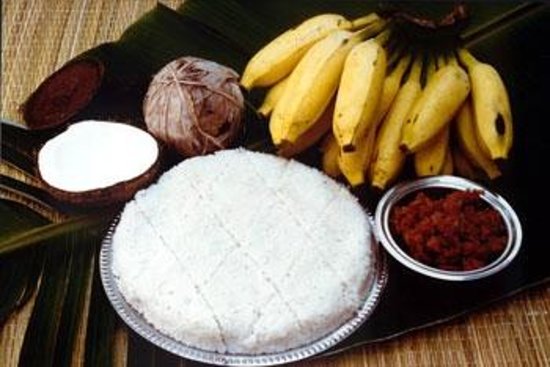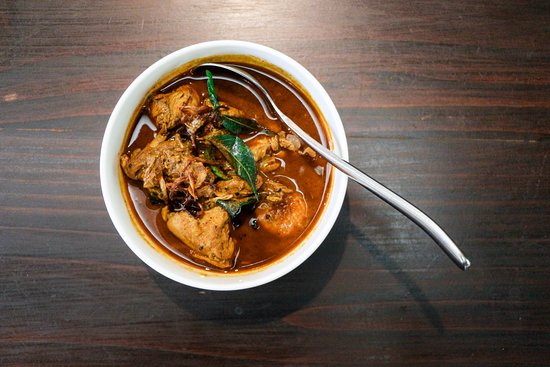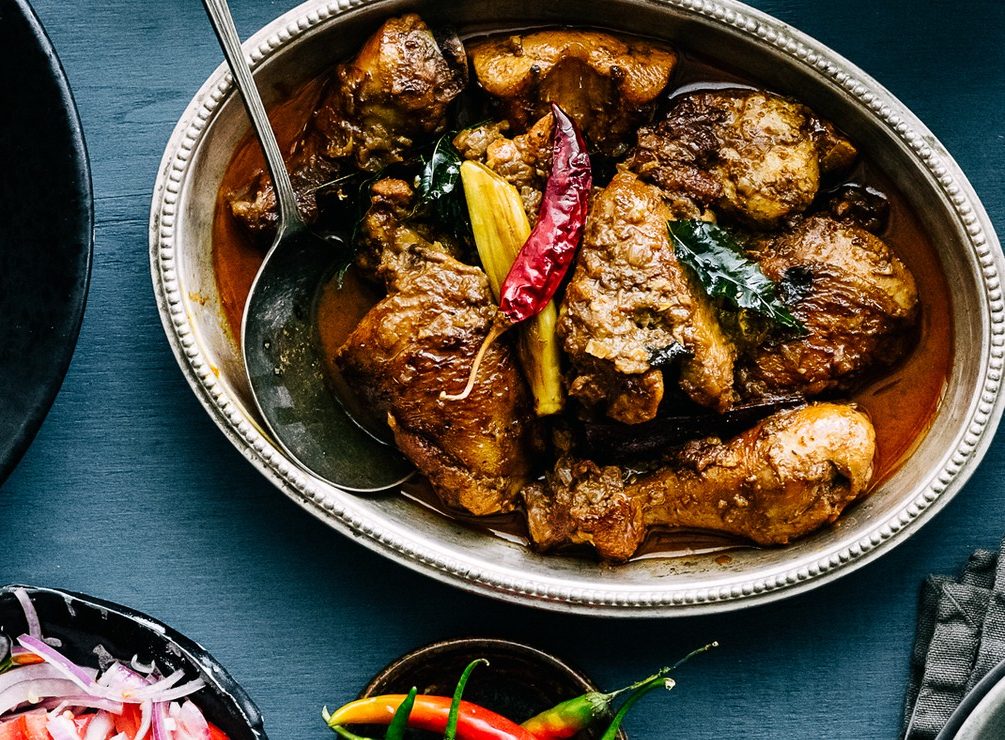Sri Lankan Food Culture by Nimasha Jayamanne
(BSc. Food Science & Technology, University of Peradeniya)
The staple food in Sri Lanka is rice. The importance of rice is evident in the Sri Lankan culture, where rice cultivation has played a key role in shaping our culture. “Rice and curry” is a staple that is cooked in every Sri Lankan household.
Rice can be as simple as plain white rice to yellow rice, tempered rice or more traditional varieties of rice such as Suwandel, Kalu Heenati, Pachchaperumal, Ma Wee and more. These traditional ones are known for their high nutritional value and medicinal value. Rice acts as the mild mediator that tames the usual fiery curries that accompany it. Although the traditional Sri Lankan curries are mainly vegetarian due to our Buddhist influence, today dishes may vary from vegetables, cereals, meat, fish, sambols, pickles and chutneys. Any vegetable or sometimes fruit can be made in to a curry using coconut milk and spices.
“Polos Ambula” is a favourite among the locals which is made with young jackfruit and loaded with spices and cooked for several hours to perfection.
The southern region of the country is known for their seafood cuisine, again loaded with a wide variety of spices. One such popular dish is “Ambul Thiyal”, which is tuna fish mixed with lots of goraka (Garcinia; used like tamarind to give a sour taste) paste and other spices.
Sri Lankans love there leafy vegetables mixed with scraped coconut called “Mallum”. Gotukola, moringa leaves and amaranthus which are labelled as “super foods” are abundantly found here in Sri Lanka.
Although rice is the staple, locals also turn to boiled jackfruit, manioc (cassava), sweet potato and various kinds of yams as their source of carbohydrates, especially for breakfast, when they are savoured together with scraped coconut and “Lunu Miris”, a local hot sauce made with lot of chillies and onions.
Spices are key ingredients in Sri Lankan cuisine and are often referred to as medicine. They are the main aspect that differentiates Sri Lankan cuisine from the Indian cuisine. Sri Lankan food is not for the mild hearted; it is unapologetically fiery, an adrenaline pumping kind of food (though you can always request for the mild versions).
Milk rice or “Kiribath” is another crowd pleaser made for any auspicious event as a sign of good luck and prosperity. It is made with rice and coconut milk and laid on a banana leaf to be cut in to diamond shaped pieces.
Aside from these, Sri Lankans also have a sweet tooth and therefore no festival goes by without making the traditional sweet meats such as kevum, mung kewum, kokis and aluwa, commonly made with rice flour, treacle and coconut milk or scraped coconut. “Helapa” is a local specialty made with finger millet flour (kurakkan), scraped coconut and treacle like a pancake wrapped inside kenda leaves and roasted on a pan.
Ceylon tea has become famous, which was introduced by the British during the colonisation as one of their main export cultivations.
Other than tea and coffee, Sri Lanka is famous for its herbal drinks, such as dried bael flower, ranawara flower, valmee and iramusu; renowned for their medicinal values and trending among the locals currently.
Kottu, hoppers and vada are popular street foods found in abundance in our cities, with different kinds of variations in across the regions of the country. They are often made during the evenings and through the night, to be found on small vending stalls by the road sides for day break. Sri Lankan street food was made popular due to the cultural shift and it has shaped the modern food culture in Sri Lanka; even restaurants offer a slightly expensive and contemporary version of the street food due to their popularity.
Other than the main Sri Lankan food which are consumed by the majority Sinhala community, Sri Lanka is also enriched with different collections of communal food as well.
The Tamil community in Sri Lanka has their own version of Indian food, slightly Sri Lankanised by using different spices, seasoning and cooking styles. Few of the highlights are Jaffna crab ,fish and lamb curries. Mutton Biriyani is also a widely popular dish amongst all Sri Lankans which has an Arabic background yet localised by the Sri Lankan Muslims.
The aboriginals of Sri Lanka, the Wedda community, have their own set of food. Their dishes are mainly filled with hunted animals like deer and rabbit. Smoked deer meat and rabbit meat seasoned in honey are a couple of their delicacies.
There is another set of food Sri Lankans have taken from the Dutch and the Portuguese and yet localised for the local palate. One such all-time favourite is lamprais (lamp rice) which is a rice boiled in chicken broth with chicken, mutton, ash plantain, eggplant, sweet onion mix, a cutlet and not forgetting a fried egg too. The whole thing comes wrapped in a baked banana leaf. It’s a must to include all the mentioned items in a lamp rice.
Milk Rice with Sri Lankan Chicken Curry by Lanka Jayamanne
Introduction :
Milk Rice & Chicken curry is an all-time Sri Lankan favourite. Milk Rice is cocked specially on auspicious days like, New Year, first day of a month, Birthdays etc. Traditionally it’s eaten with a homemade chili paste which includes, onion, chilies, paper, dried maldivefish. Sri Lankans eat this only for breakfast. Since it’s a very heavy meal, it can also be served for lunch. A black coffee will help you to stay awake after the meal but if you still feel drowsy, don’t feel guilty to hit the bed.
Required ingredients for Milk Rice:
Rice :500g (Serves for 4)
Coconut milk : 2 ½ Cups
Water : 850 ml
Salt : tea spoon
Steps:
*Wash the rice and drain the water.
* Put the rice in a rice cocker and add the water.
** You can now start preparing the chicken curry till it boils.
* Add salt to the coconut milk.
* When the rice is properly cocked, add the coconut milk.
*Mash the rice with a flat wooden spoon.
*Keep stirring the rice till the coconut milk.
* Let the rice absorbs all the coconut milk and let the rice get thicker.
* Lay the rice (now milk rice) to a nonstick tray.
* Flatten the rice with the wooden spoon to make a layer (about an inch in thickness)
* Cut the mile rice into diamond shaped pieces. (you can also cut it square) and serve.
Required ingredients for the Chicken Curry.
Skinless chicken with bones. 600g
Onion (thinly sliced) : 1 onion
Green chili (thinly sliced) : 2 chilies
Pandan leaves : 4 inches (also known as screw pine leaves) if not use curry leaves.
Cinnamon – 1 inch piece.
Garlic (chopped) : 5 cloves.
Ginger (chopped). 1 inch piece.
Tomato (sliced) : 2 medium size.
Cardamom (2) Cloves (2)
Sri Lankan Black Curry powder 1 teaspoon (which can be bought from super markets)
Chili powder 2 teaspoons
Pepper ½ teaspoon
Coconut oil (or Vegetable oil) – 2 table spoons.
Salt : teaspoon (or as required)
Steps
*Keep the pan on cooker on medium heat.
* When the oil is warm enough, add garlic, onion and pandan leaves.
* Keep stirring for 1 minute.
* Add Cardamom and cloves and keep stirring. (30 seconds)
*Add chili powder to the mixer to get a nice dark red colour.
* Then add curry powder.
* Next add diced chicken and mix well to cover the chicken with the spicy mixture.
* Let it cook for about 5 minutes. Keep changing the sides of the chicken.
*Then add coconut milk and let it cook on medium heat for about 20 mins.
*You can taste the curry and add more salt if needed because the chicken absorbs salt while cooking.
    |
#traditional #homecooking #authentic #authenticsrilanka #srilankanfood #destinationsrilanka #sosrilanka #travelsrilanka #srilankatravel #ttcsrilanka #thetravelconciergesrilanka
For further information and bookings, contact Wilam direct at TTC Sri Lanka anz@ttcsrilanka.com
Are you following us on Instagram?
Follow us on Instagram @thetravelconciergesrilanka
Booking enquires anz@ttcsrilanka.com WhatsApp +94 71 116 1020
Sales enquires Laahiru Jayamanne, Director laahiru@ttcsrilanka.com






